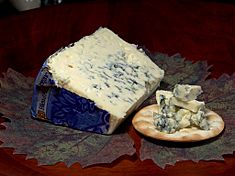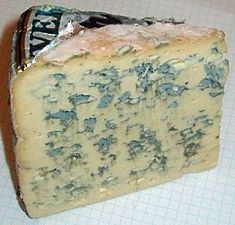Bleu d'Auvergne facts for kids
Quick facts for kids Bleu d'Auvergne |
|
|---|---|
 Bleu d'Auvergne  Texture of Bleu d'Auvergne |
|
| Country of origin | Lua error in Module:Wikidata at line 70: attempt to index field 'wikibase' (a nil value). |
| Region | Auvergne |
| Source of milk | Cow's milk |
| Pasteurized | Depends on variety |
| Texture | Soft |
| Aging time | 2 months |
| Certification | AOC Auvergne 1975 |
| Named after | Lua error in Module:Wikidata at line 70: attempt to index field 'wikibase' (a nil value). |
Bleu d'Auvergne (say "Bloo doh-VAIR-nyuh") is a famous French blue cheese. It gets its name from the Auvergne region in central France, where it first came from. This cheese is made using milk from cows. The French government has given it a special certification called "Appellation d'origine contrôlée," which means it's a protected and traditional product.
Contents
The Story of Bleu d'Auvergne
The story of Bleu d'Auvergne began around the 1850s. A French cheesemaker named Antoine Roussel created it. He noticed that blue molds growing on his cheese curds tasted good.
Antoine Roussel wanted to make more of this tasty blue mold. He tried different ways to make the blue veins appear in his cheese. After many tries, he found a solution. He used mold from rye bread. He also poked holes in the cheese curds with a needle.
Poking holes let more air get inside the cheese. This extra oxygen helped the blue mold grow well in the air pockets. Soon, Antoine's amazing discovery and methods spread throughout the Auvergne region.
How Bleu d'Auvergne is Made
Today, Bleu d'Auvergne cheese is made using machines. These machines help poke the holes in the cheese. This is similar to Antoine Roussel's original idea.
After the holes are made, the cheese is aged. It spends about four weeks in cool, damp cellars. This aging process is quite short for a blue cheese. Once it's ready, the cheese is sent out to stores.
What Bleu d'Auvergne Tastes Like
Bleu d'Auvergne has a strong and sharp taste. However, it's not as strong as some other blue cheeses. It has less salt, which makes it taste creamier. It also has a buttery flavor and a moist texture.
Some types of Bleu d'Auvergne use a milder mold. This mold is called Penicillium glaucum. Other blue cheeses, like Roquefort, use a stronger mold called Penicillium roqueforti.
How to Enjoy Bleu d'Auvergne
Bleu d'Auvergne is a very versatile cheese. People often use it in salad dressings. It's also great for seasoning pasta dishes. You can also simply enjoy it as a snack.
Many people say this cheese goes well with sweet wines. Examples include dessert wines like Riesling or Sauvignon Blanc. It also pairs nicely with strong red wines. For beer lovers, dark beers like English barley wine or American porter are good choices. These drinks have both sweetness and bold flavors that balance the cheese.
See also
 In Spanish: Bleu d'Auvergne para niños
In Spanish: Bleu d'Auvergne para niños

